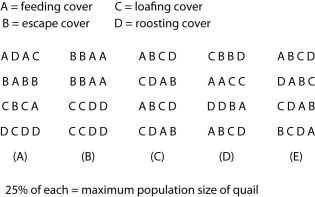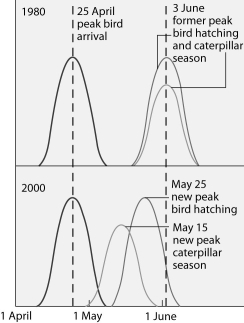A) Costa Rica
B) Canada
C) China
D) United States
E) Mexico
G) All of the above
Correct Answer

verified
Correct Answer
verified
Multiple Choice
 -Study the information above about quail habitats. Which of these represents the best quail habitat in terms of fragmentation and edge?
-Study the information above about quail habitats. Which of these represents the best quail habitat in terms of fragmentation and edge?
A) A
B) B
C) C
D) D
E) E
G) C) and E)
Correct Answer

verified
Correct Answer
verified
Multiple Choice
Which of the following is consistent with forest fragmentation research?
A) Productivity is the same in both fragmented forests and forest interiors.
B) Edge communities consistently have low species diversity.
C) Forest-interior species show declines in small patch communities.
D) New-edge species that migrate in do not seem to compete with forest species and often increase biodiversity in fragmented forests.
E) Species diversity is always lower in fragmented forests when compared to forest interiors in the same region.
G) B) and E)
Correct Answer

verified
Correct Answer
verified
Multiple Choice
Your friend is wary of environmentalists' claims that global warming could lead to major biological change on Earth. Which of the following statements can you use in response to your friend's suspicions?
A) We know that atmospheric carbon dioxide has increased over the past 150 years.
B) Through measurements and observations, we know that CO₂ levels and temperature fluctuations are directly correlated, even in prehistoric times.
C) Global warming could have significant effects on agriculture in the United States.
D) Sea levels will likely rise, displacing as much as 50% of the world's human population.
E) All statements listed could be used.
G) B) and C)
Correct Answer

verified
Correct Answer
verified
Multiple Choice
For the following questions, match the statement with the appropriate term/phrase. -This causes an increase in the intensity of UV radiation reaching Earth.
A) depletion of ozone layer
B) acid precipitation
C) biological magnification
D) greenhouse effect
E) eutrophication
G) B) and C)
Correct Answer

verified
Correct Answer
verified
Multiple Choice
Which of the following ecological locations has the greatest species diversity?
A) tundra
B) deciduous forests
C) tropics
D) grasslands
E) islands
G) A) and C)
Correct Answer

verified
Correct Answer
verified
Multiple Choice
Which of the following strategies would most rapidly increase the genetic diversity of a population in an extinction vortex?
A) Capture all remaining individuals in the population for captive breeding followed by reintroduction to the wild.
B) Establish a reserve that protects the population's habitat.
C) Introduce new individuals transported from other populations of the same species.
D) Sterilize the least fit individuals in the population.
E) Control populations of the endangered population's predators and competitors.
G) C) and E)
Correct Answer

verified
Correct Answer
verified
Multiple Choice
Which of the following groups is most threatened by global extinctions?
A) mammals
B) birds
C) fish
D) amphibians
E) plants
G) A) and D)
Correct Answer

verified
Correct Answer
verified
Multiple Choice
Which of the following is the most direct threat to biodiversity?
A) increased levels of atmospheric carbon dioxide
B) the depletion of the ozone layer
C) overexploitation of selected species
D) habitat destruction
E) zoned reserves
G) C) and D)
Correct Answer

verified
Correct Answer
verified
Multiple Choice
Introduced species can have deleterious effects on biological communities by
A) preying on native species.
B) competing with native species for food or light.
C) displacing native species.
D) competing with native species for space or breeding/nesting habitat.
E) All of the options are correct.
G) C) and D)
Correct Answer

verified
Correct Answer
verified
Multiple Choice
Which of the following species was driven to extinction by overexploitation by hunters/fishermen?
A) African elephant
B) the great auk
C) North American bluefin tuna
D) flying foxes
E) American bison
G) B) and D)
Correct Answer

verified
Correct Answer
verified
Multiple Choice
Of the following ecosystem types, which have been impacted the most by humans?
A) wetland and riparian
B) open and benthic ocean
C) desert and high alpine
D) taiga and second-growth forests
E) tundra and arctic
G) None of the above
Correct Answer

verified
Correct Answer
verified
Multiple Choice
The most serious consequence of a decrease in global biodiversity would be the
A) increase in global warming and thinning of the ozone layer.
B) potential loss of ecosystem services on which people depend.
C) increase in the abundance and diversity of edge-adapted species.
D) loss of source of genetic diversity to preserve endangered species.
E) loss of species for "bioprospecting."
G) None of the above
Correct Answer

verified
Correct Answer
verified
Multiple Choice
Which of the following is a type of research in which a conservation biologist would be involved?
A) reestablishing whooping cranes in their former breeding grounds in North Dakota
B) studying species diversity and interaction in the Florida Everglades, past and present
C) studying population ecology of grizzly bears in Yellowstone National Park
D) determining the effects of hunting white-tailed deer in Vermont
E) determining the effect of protection programs on the recovery of the North Atlantic cod fishery
G) None of the above
Correct Answer

verified
Correct Answer
verified
Multiple Choice
One characteristic that distinguishes a population in an extinction vortex from most other populations is that
A) its habitat is fragmented.
B) it is a rare, top-level predator.
C) its effective population size is much lower than its total population size.
D) its genetic diversity is very low.
E) it is not well adapted to edge conditions.
G) C) and E)
Correct Answer

verified
Correct Answer
verified
Multiple Choice
Use the graph and information provided in the paragraph below to answer the following questions.
Flycatcher birds that migrate from Africa to Europe feed their nestlings a diet that is almost exclusively moth caterpillars. The graph below shows the mean dates of arrival, bird hatching, and peak caterpillar season for the years 1980 and 2000.
 -Why were ecologists concerned about the shift in the peak caterpillar season from June 3, 1980, to May 15, 2000?
-Why were ecologists concerned about the shift in the peak caterpillar season from June 3, 1980, to May 15, 2000?
A) The caterpillars would have eaten much of the foliage of the trees where flycatchers would have nested, rendering their nests more open to predation.
B) The earlier hatching of caterpillars would compete with other insect larval forms which the flycatchers would also use to feed their young.
C) The 2000 flycatcher nestlings would miss the peak caterpillar season and might not be as well fed.
D) The flycatchers would have to migrate sooner to match their brood-rearing to the time of peak caterpillar season.
E) Pesticides, which have a negative effect on the ecosystem, would have to be used to control the earlier outbreak of caterpillar hatching.
G) A) and B)
Correct Answer

verified
Correct Answer
verified
Multiple Choice
The word triage originated during World War I and was first used by French doctors in prioritizing patients based on the severity of their wounds, because there were more wounded soldiers in need of urgent care than there were resources to treat them. Conservation biologists have to make similar determinations with degraded ecosystems. Which of the following is the most important consideration when it comes to managing for maintenance of biodiversity?
A) identifying large, high-profile vertebrates first, because steps to saving them would be most recognized by the public
B) determining which species is most important for conserving biodiversity as a whole
C) replanting suitable habitat for fauna
D) assessing the economic costs and the gains for society
E) maintaining optimum size of all populations in the ecosystem
G) B) and D)
Correct Answer

verified
Correct Answer
verified
Multiple Choice
What is the single greatest threat to biodiversity?
A) overharvesting of commercially important species
B) introduced species that compete with native species
C) pollution of Earth's air, water, and soil
D) disruption of trophic relationships as more and more prey species become extinct
E) habitat alteration, fragmentation, and destruction
G) B) and C)
Correct Answer

verified
Correct Answer
verified
Multiple Choice
Which of the following examples poses the greatest potential threat to biodiversity?
A) replanting, after a clear cut, a monoculture of Douglas fir trees on land that consisted of old-growth Douglas fir, western cedar, and western hemlock
B) allowing previously used farmland to go fallow and begin to fill in with weeds and then shrubs and saplings
C) trapping and relocating large predators, such as mountain lions, that pose a threat as they move into areas of relatively dense human populations
D) importing an Asian insect into the United States to control a weed that competes with staple crops
E) releasing sterilized rainbow trout to boost the sport fishing of a river system that contains native brook trout
G) A) and C)
Correct Answer

verified
Correct Answer
verified
Multiple Choice
The primary difference between the small-population approach (S-PA) and the declining-population approach (D-PA) to biodiversity recovery is
A) S-PA is interested in bolstering the genetic diversity of a threatened population rather than the environmental factors that caused the population's decline.
B) S-PA kicks in for conservation biologists when population numbers fall below 500.
C) D-PA would likely involve bringing together individuals from scattered small populations to interbreed in order to promote genetic diversity.
D) S-PA would investigate and eliminate all of the human impacts on the habitat of the species being studied for recovery.
E) D-PA would use recently collected population data to calculate an extinction vortex.
G) D) and E)
Correct Answer

verified
Correct Answer
verified
Showing 41 - 60 of 67
Related Exams